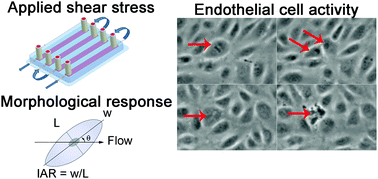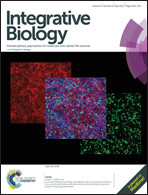Real-time quantification of endothelial response to shear stress and vascular modulators†
Abstract
Quiescence is commonly used to describe the inactive state of endothelial cells (ECs) in monolayers that have reached homeostasis. Experimentally quiescence is usually described in terms of the relative change in cell activity (e.g. turnover, speed, etc.) in response to a perturbation (e.g. solute, shear stress, etc.). The objective of this study is to provide new insight into EC quiescence by quantitatively defining the morphology and activity of confluent cell monolayers in response to shear stress and vascular modulators. Confluent monolayers of human umbilical vein ECs (HUVECs) were subjected to a range of shear stresses (4–16 dyne cm−2) under steady flow. Using phase contrast, time-lapse microscopy and image analysis, we quantified EC morphology, speed, proliferation, and apoptosis rates over time and detected differences in monolayer responses under various media conditions: basal media supplemented with growth factors, interleukin-8, or cyclic AMP. In all conditions, we observed a transition from cobblestone to spindle-like morphology in a dose-dependent manner due to shear stress. Cyclic AMP enhanced the elongation and alignment of HUVECs due to shear stress and reduced steady state cell speed. We observed the lowest proliferation rates below 8 dyne cm−2 and found that growth factors and cyclic AMP reduced proliferation and apoptosis; interleukin-8 similarly decreased proliferation, but increased apoptosis. We have quantified the response of ECs in confluent monolayers to shear stress and vascular modulators in terms of morphology, speed, proliferation and apoptosis and have established quantifiable metrics of cell activity to define vascular quiescence under shear stress.



 Please wait while we load your content...
Please wait while we load your content...